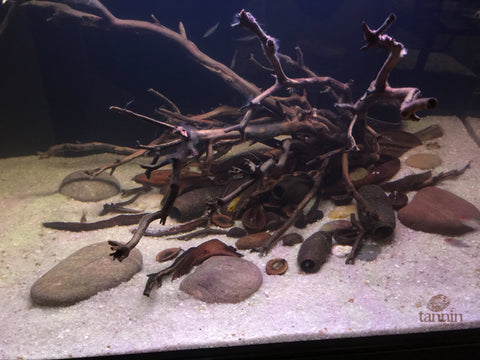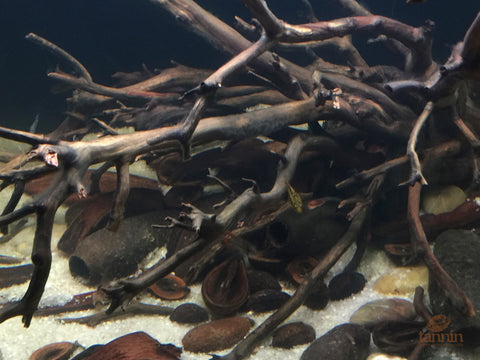- Continue Shopping
- Your Cart is Empty
Embracing the evolution in a "New Botanical Style" Aquarium...
Did you ever think about how an aquarium "evolves" over time?
I mean, when you first set up a tank, it starts out as this semi-sterile acrylic or glass box, and slowly but surely evolves into a living, functioning ecosystem...if, of course, we let it!
Like many of you, I've set up hundreds and hundreds of aquariums in my lifetime, each one was somehow different; an independent, unique little system with its own quirks, norms, and surprises. However, my last several freshwater aquariums have embraced what I've half-jokingly referred to as the "New Botanical Style"- systems which utilize multiple forms of aquatic botanicals and wood as the basis of the aquascape- and the aquatic environment.

Sure, I'm absolutely not the first person to through leaves and such into an aquarium. Of course, it would be incredibly arrogant and just plain wrong to take such a viewpoint! However, I think that I might be one of perhaps a much smaller number of aquarists who has really taken the time to sit down and embrace what is actually occurring in his "botanical-heavy" system, realizing that everything is operating as part of a greater "whole", contributing to the richness of the aquatic environment as the system evolves biologically, chemically, and aesthetically.

As such, these "New Botanical Style" tanks have a diverse assemblage of organic materials in the form of wood, seed pods, leaves, etc. Each item was selected not only for aesthetics, but for certain "capabilities" it brings to the environment. I believe that a "New Botanical Style" system embraces the evolving processes which occur when these materials interact with their aquatic environment, imparting tannins, humic acids, etc. to the water, for the benefit of the life forms contained within. Embracing the breakdown, decomposition- the change which occurs within the system- physically, aesthetically, and chemically, as at evolves.

In my most recent aquarium, a fabulous Innovative Marine "Fusion Lagoon 50", which I've been sharing with you on these pages and in social media, was set up with the intention of allowing the tannins and such contained in the wood and botanicals to be released "in their own time", and in as natural a fashion as possible. I also made the "command decision" to "soak" my Manzanita wood inside the display aquarium rather than in an external vessel of some sort- something I am always hesitant to do.

Why? Because the wood will release a lot of bound-up organic material, in addition to tannins and other chemicals, not to mention good old fashion detritus and such- bound up on and within its structure. This has a direct impact in the water in a number of ways- not the least of which is the "bloom" of bacteria which arise as the wood becomes saturated.

Couple this with the breakdown of a significant number of other botanicals as well, and the result was about 3 weeks of pretty cloudy water, which is never a fun thing to deal with. However, with patience, frequent small water changes with prepared RO/DI water, and the use of modest amounts of chemical filtration media (I love SeaChem Purigen), I "endured" this cloudiness and began to see the wonderful brown color, clarity and richness that I've come to expect from a blackwater system.

Yes, I had to endure the "yucky biofilm phase" with my botanicals, just like many of you do. I had to remove a few pieces that got that nasty, hydrogen sulfide smell. I did some "aesthetic edits", removing what I felt were pieces that either detracted from the appearance I was trying to achieve, or were otherwise incongruous with the rest of the 'scape.

What I never did- in fact, what I never DO- is to make knee-jerk "panic decisions" and take extraordinary measures to "correct" what appear to be "problems" in the system. It pays to reevaluate and analyize just what made these "problems" arise in the first place, so you can decide what, if any- action you SHOULD take. In my case, I knew what I was in for: Cloudiness caused by my decision to "cure" the wood in the aquarium proper, and the biofilms and such that you see from using large quantities of aquatic botanicals in the system from the outset.
Rather than panic, I did water testing, which revealed no detectible nitrite, phosphate, or ammonia during this period. The pH was stable and the fishes that were present were perfectly fine. I decided to embrace all of the process that were occurring within my system, and understood that the aquatic environment was evolving.

That being said, did I enjoy the "yucky biofilm phase" or cloudy water? Of course not. However, I DID understand why they were occurring, and appreciated the natural processes, helped by my regular maintenance procedures (standard weekly 10% water changes) that were letting the system "do its thing." Perhaps that patience, borne from decades of reef keeping, where you simply have to let things evolve if you want long-term success- has become the key ingredient in my aquarium management philosophy.
Here we are, about five weeks after the aquarium was set up, and things have truly "evolved" past what I call the "Initial Phase" (where everything is still kinda new and sterile) and evolved into the "Living Phase", when an aquarium starts to literally take on a life of its own, becoming less dependent upon the "management" of its owner to overcome issues like nuisance algae, cloudiness, etc. We're now seeing the richness of the aquatic environment starting to emerge: The botanicals have softened and saturated, the wood has a minimal coverage of biofilm or nuisance algae of any kind, and the water has that clarity and clean, "earthy" smell of a healthy aquarium. Environmental parameters are stable. And of course, the "tint" caused by the release of tannins is increasingly evident!

The fish population has, of course, increased gradually (I'm a FISH GEEK, for goodness sake!), and with it, the biological demand on the system. However, I've learned a thing or two over the years, like most of you- the most important lesson being to be patient and add fishes slowly. In a "New Botanical Style" system, with little or no higher plants to help uptake the nutrients released into the system by the botanicals, wood, and fishes, it's more important than ever to go slowly and take that "it's a Marathon, not a sprint" mentality of tank management.

This embracing of what is happening in the aquarium, and taking it all into consideration as part of the evolution of this ecosystem, has made the experience of starting this tank more enjoyable than virtually any freshwater or reef system I've set up previously. As I see and hear from more and more of you working with this "New Botanical Style" system, I realize that we are actually at a sort of interesting time in the hobby: We have all of these amazing technical advantages, yet we are at a point where we can sit back, embrace, and appreciate all of the amazing work that nature does.
I very much enjoy hearing from all of you as you gain more an more experience working with aquatic botanicals and being part of the exciting "moment" of creating "New Botanical Style" aquariums!
Stay excited. Stay experimental. Stay open minded...
And Stay Wet.
Scott Fellman
Tannin Aquatics






Scott Fellman
Author